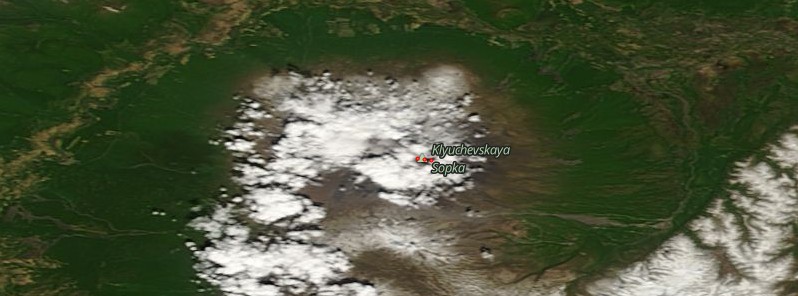Klyuchevskoy erupts sending ash up to 6 km, Russia

Russia's Klyuchevskoy volcano erupted late June 13, 2016, sending a column of smoke and ash high into the sky.
At 22:09 UTC, a plume of ash reached an altitude of 5 – 6 km (16 400 – 19 680 feet) above sea level. At of 21:29 UTC, ash plume extended 47 km (29 miles) to the west, KVERT reported.
Aviation Color Code remains on Orange since April 24, 2016.
The explosive eruption of the volcano continues and ash explosions up to 6 to 8 km (19 700 to 26 240 feet) a.s.l. could occur at any time, KVERT said. Ongoing activity could affect international and low-flying aircraft.
Klyuchevskoy has been almost continuously active over the past 50 years. This latest phase of strong strombolian activity started at 11:25 UTC on April 3, 2016, when a bright incandescence was observed at the summit crater.
Around 13:40 UTC on April 23, strong explosions at the volcano sent ash up to 9 km (29 527 feet) above sea level.
Geological summary
Klyuchevskoy (also spelled Kliuchevskoi) is Kamchatka's highest and most active volcano. Since its origin about 6000 years ago, the beautifully symmetrical, 4835-m-high basaltic stratovolcano has produced frequent moderate-volume explosive and effusive eruptions without major periods of inactivity. It rises above a saddle NE of sharp-peaked Kamen volcano and lies SE of the broad Ushkovsky massif. More than 100 flank eruptions have occurred during the past roughly 3000 years, with most lateral craters and cones occurring along radial fissures between the unconfined NE-to-SE flanks of the conical volcano between 500 m and 3600 m elevation.
The morphology of the 700-m-wide summit crater has been frequently modified by historical eruptions, which have been recorded since the late-17th century. Historical eruptions have originated primarily from the summit crater, but have also included numerous major explosive and effusive eruptions from flank craters. (GVP)
Featured image: Klyuchevskoy on June 14, 2016. Credit: NASA Terra/MODIS

Commenting rules and guidelines
We value the thoughts and opinions of our readers and welcome healthy discussions on our website. In order to maintain a respectful and positive community, we ask that all commenters follow these rules:
We reserve the right to remove any comments that violate these rules. By commenting on our website, you agree to abide by these guidelines. Thank you for helping to create a positive and welcoming environment for all.